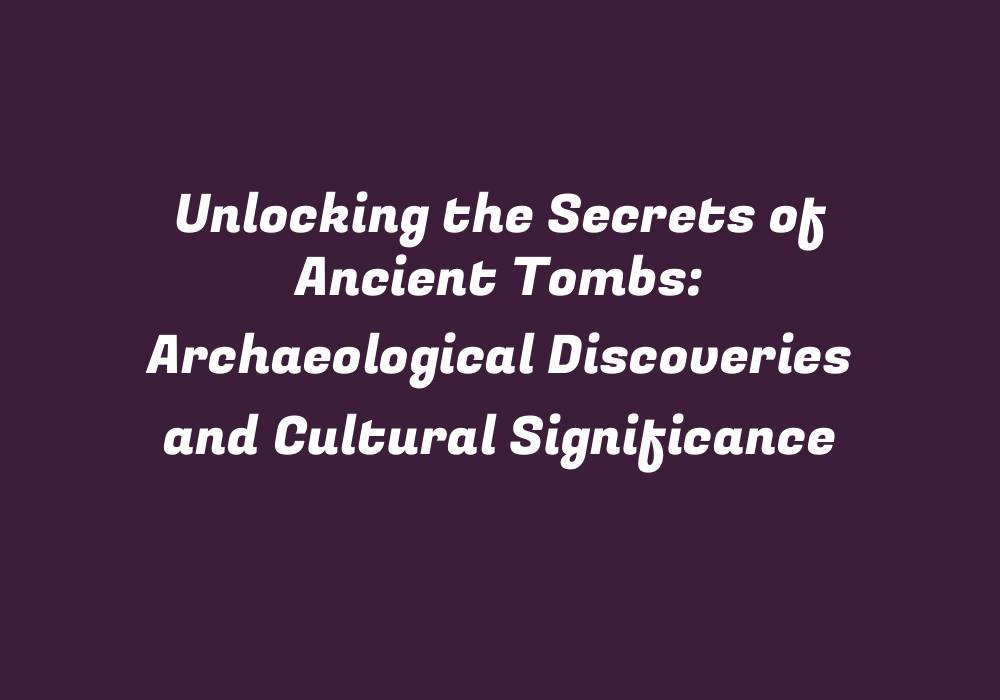Introduction
Introduction
Ancient tombs have always held a profound fascination for modern archaeologists and the general public alike. They serve as windows into the past, offering glimpses into long-forgotten cultures and civilizations. Uncovering these treasures not only helps us understand their historical significance but also deepens our appreciation for cultural diversity across ages. In this article, we will delve into some of the most significant archaeological discoveries made in ancient tombs, highlighting their importance to culture and society.
The Valley of the Kings: Egypt’s Royal Tombs
The Valley of the Kings: Egypt’s Royal Tombs
One of the world’s most famous archaeological sites lies in the Valley of the Kings, located on the west bank of the Nile River in Egypt. This region has been a treasure trove for discoveries about the Egyptian civilization during the New Kingdom period (1570-1069 BC). Among the many tombs in this area, the most famous are those belonging to King Tutankhamun and Ramses VI.
King Tutankhamun’s tomb was discovered by Howard Carter in 1922. It has become a symbol of wealth and power due to its exquisite treasures such as the golden burial mask, jewelry, and chariots. On the other hand, Ramses VI’s tomb revealed unique insights into Egyptian art, architecture, and religious beliefs. Its wall paintings depict scenes of daily life during his reign, providing a valuable record of ancient Egyptian culture.
China’s Terracotta Warriors: The Eighth Wonder of the World
China’s Terracotta Warriors: The Eighth Wonder of the World
Perhaps one of the most amazing archaeological discoveries in recent history is the Terracotta Army, which was found by accident near the tomb of China’s first Qin Emperor, Qin Shi Huang. Discovered between 1974 and 1976, these life-sized terracotta figures were created to protect the emperor during his afterlife journey. This archaeological find offers a rare glimpse into ancient Chinese warfare strategies and craftsmanship.
The Terracotta Army comprises an estimated 8,000 soldiers, horses, chariots, and weapons, all buried to accompany the emperor in his final resting place. The figures are unique not only for their realism but also due to the intricate details of their clothing and weaponry, which provide valuable insight into the Qin dynasty’s military strength and social structure.
The Maya Temples: A Journey Through Ancient Mesoamerica
The Maya Temples: A Journey Through Ancient Mesoamerica
The ancient Maya civilization flourished in what is now Central America and Mexico between 2000 BC and AD 900. Their complex society was built around their religion, with pyramid temples playing a central role in religious ceremonies and rituals. One of the most famous examples of these architectural marvels is the Temple of Kukulcan at Chichen Itza in Mexico.
The Temple of Kukulcan (or El Castillo) showcases both architectural sophistication and astronomical knowledge, with its steps forming a series of geometric patterns corresponding to the cycles of Venus and the Mayan solar year. The site also features other significant structures like the Great Ball Court and the Sacred Cenote, revealing much about ancient Maya culture, rituals, and beliefs.
Ramses II’s Tomb: The Unopened Mystery of Ancient Egypt
Ramses II’s Tomb: The Unopened Mystery of Ancient Egypt
One of the most intriguing unsolved mysteries in archaeology is the tomb of Ramses II, one of the most powerful pharaohs of the New Kingdom. His massive tomb complex was constructed on the western bank of the Nile River near Thebes and completed around 1245 BC. However, it has remained largely unexplored since its construction due to a series of political turmoil and natural disasters that have blocked the entrance to the chamber.
The tomb’s undisturbed condition leaves archaeologists with the rare opportunity to study an intact royal burial site. Its contents could provide valuable insights into Ancient Egyptian beliefs, art, architecture, and rituals during Ramses II’s reign. Moreover, it may uncover new information about his relationship with ancient civilizations in other regions such as Greece and Syria.
Conclusion
Conclusion
Ancient tombs have long been a source of fascination for archaeologists and the general public alike, allowing us to unravel the mysteries of ancient civilizations. From the Valley of the Kings in Egypt to China’s Terracotta Warriors and the Maya Temples of Central America, these discoveries have transformed our understanding of cultural diversity and artistic expression across history. Each new excavation yields fresh perspectives on how societies evolved over time and highlights the complex interplay between religion, politics, and art.
As more archaeological sites are unearthed, we can expect further revelations about the past’s rich tapestry of human experiences, beliefs, and achievements. With these discoveries comes a deeper appreciation for the vastness of our history, reminding us that our understanding of the world is ever-evolving and constantly being shaped by newfound knowledge.
